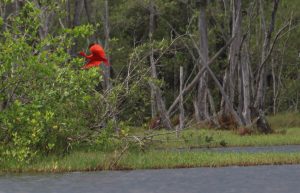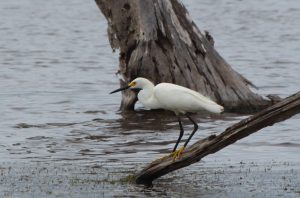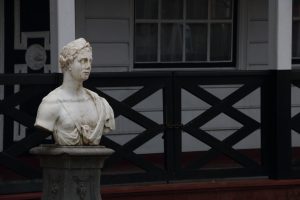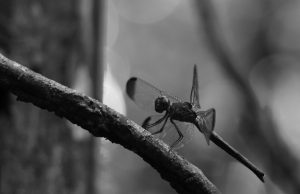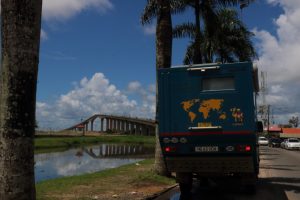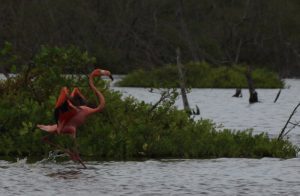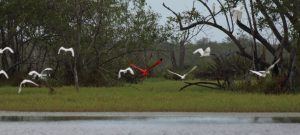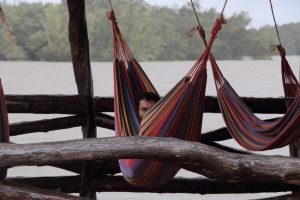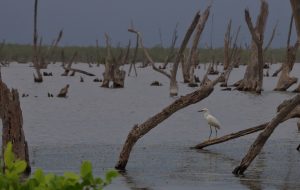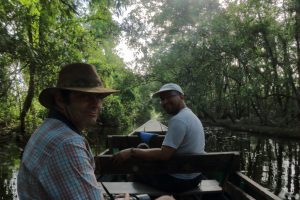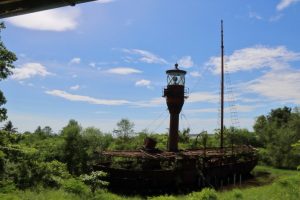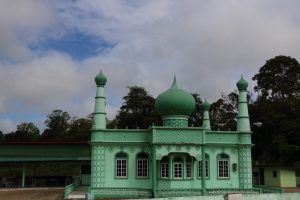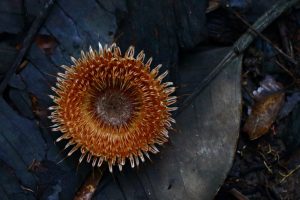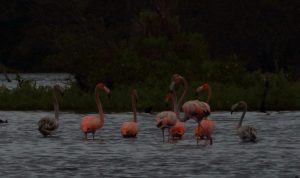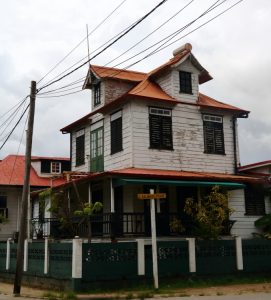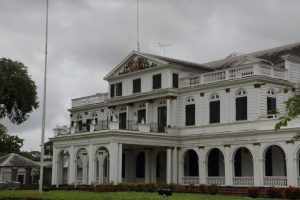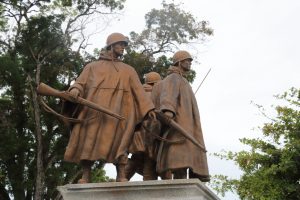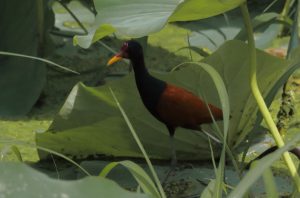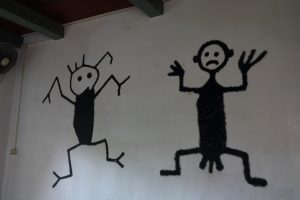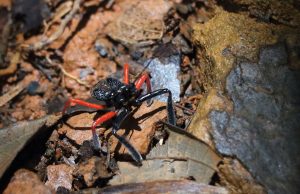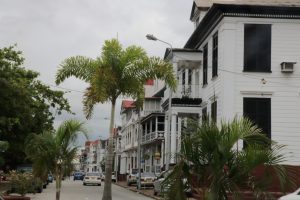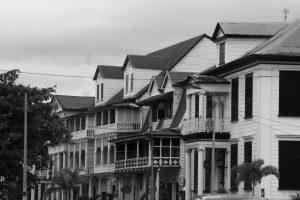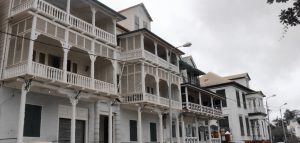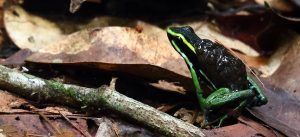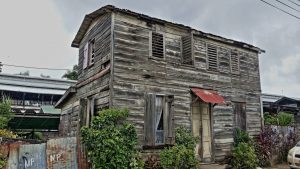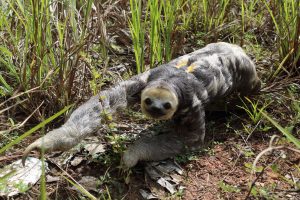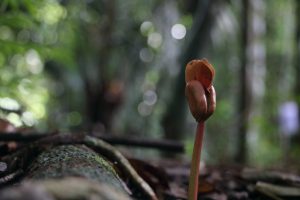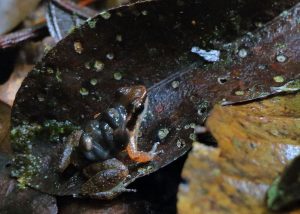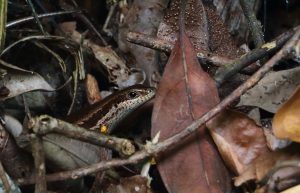Suriname, Suriname… where exactly is that? Near Vietnam? Nope. Next door to Ghana? Errr, no. It’s on the north coast of South America, above Brazil, snuggled comfortably between French Guiana and Guyana. It’s in the northern Amazon basin, so it’s hot, humid and – at the risk of stating the bleedin’ obvious – jungly! We’ve been here a month now and one of our highlights has been entertaining jungle kids with their first ever drone sighting (click here). But Suriname has some history, great wildlife and other stuff to see too, including some interesting ‘bird-cage culture’. Here’s the Suriname travel blog…
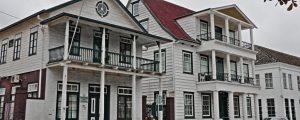
Colonial
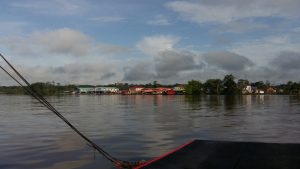
Arrival Suriname
We drove off the Maroni River ferry from French Guiana following our new friend and fellow overlander, Erick from Costa Rica. In the river-side town of Albina we noticed some significant new features. First, a sign reminding us to drive on the left. Okay… we haven’t done that for a while. The road quality is okay here, but noticeably worse than in French Guiana. Then there’s the language… Dutch is the dominant language, although there are local indigenous languages too, and many people speak English if prompted. Then there’s the food culture. It was 08:00 hrs as we arrived, but in Albina we saw not one single café with tables full of locals lingering long-time over coffee. So that’s another difference from French Guiana then!
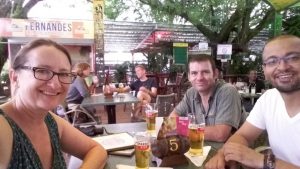
It would be rude not to try the local beer
Once upon a time Suriname was known as Dutch Guyana. It’s the bit of land that the Dutch managed to hold onto when, in the early 1800s, the Brits, French, Portugese and Spanish each nabbed a share of the original Dutch colony of Guiana. Unlike French Guiana next-door, which is still a fully signed-up Department of France, Suriname has since 1975 been very much independent from The Netherlands and is doing its own thang.
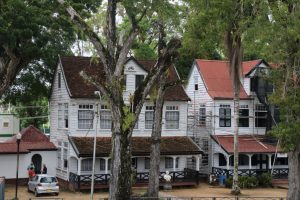 What Suriname does have in common with French Guiana is a huge, marvellous melting-pot of migrant cultures. Much of the population is of Afro-Caribbean origin, but the colonial legacy means that The Netherlands contributes most of the European immigrants. There are many people of Indian and Asian descent, but by far the largest proportion of the traders are the Chinese. There is scarcely a business of any kind that does not feature a huge Chinese language sign outside. Food, car-parts, clothes, hardware, electronics… you name it, they’re enterprising and have cornered the market.
What Suriname does have in common with French Guiana is a huge, marvellous melting-pot of migrant cultures. Much of the population is of Afro-Caribbean origin, but the colonial legacy means that The Netherlands contributes most of the European immigrants. There are many people of Indian and Asian descent, but by far the largest proportion of the traders are the Chinese. There is scarcely a business of any kind that does not feature a huge Chinese language sign outside. Food, car-parts, clothes, hardware, electronics… you name it, they’re enterprising and have cornered the market.
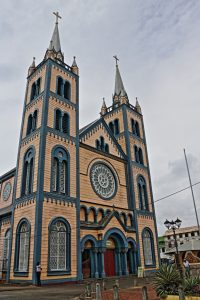 The local beer is Parbo and it’s pretty good. Much of the food is tasty creole-based, whilst much of the attitude is a relaxed Caribbean-style ‘Yeah man’!
The local beer is Parbo and it’s pretty good. Much of the food is tasty creole-based, whilst much of the attitude is a relaxed Caribbean-style ‘Yeah man’!
The capital city of Paramaribo has a lovely historic centre with a distinctive blue and yellow cathedral (allegedly the tallest wooden structure in South America, but it’s not the only place claiming this accolade!). The streets are packed with beautiful colonial-style homes, in a better or lesser state of restoration and repair.
Outside of this down-town area, the historical attractions that Suriname has to offer are suffering somewhat from the classic ‘vicious circle’: not many people visit them, ergo they receive minimal financial support, ergo they’re not well maintained, ergo not many people visit them 🙁 . That’s not so say they’re not interesting, you just have to use your imagination a bit! Fort Nieuw Amsterdam with its greatly overgrown fortifications, is a classic example of this.
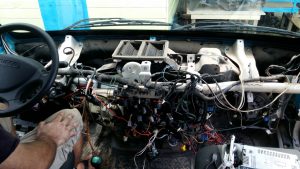
Hope he can put it all back again 🙂
Touristy-stuff aside… life on the road isn’t all about sight-seeing you know! We do have some boring admin things to do as well occasionally: cleaning, laundry, shopping, blah, blah, blah (just thought we’d put that out there and wait for the messages of sympathy to come flooding in 🙂 ). Photo sorting always seems to take way more time than we expect (p’raps we shouldn’t take so many then!) Then of course, there’s Blog writing and maintenance on Cuthbert too.
The air-con in the front cab has been less-than-sparkling over the last few weeks, which is really just not-on with this heat and humidity! Marcus had to take the whole front dash-board apart to get to the bit to fix, but it was worth the effort! We now have a lovely cool cab for the long-haul drives 🙂 Marcus has also noticed that the rear shock-absorbers are past their best. Cuthbert-spec shocks aren’t available off-the-shelf in most countries, but we find a local supplier in Paramaribo who can import these from Europe for a very reasonable price. They take a couple of weeks to arrive, but it saves us a lot of hassle that we would certainly have had importing them ourselves. Marcus fits the new shocks and Cuthbert is now bouncing along nicely!
Bird-cage Culture
One of the interesting pass-times that we have noticed amongst locals in this region, in French Guiana and here in Suriname, is that of keeping song-birds in small cages (yes, I know… controversial… but they do). The local chaps – and it does seem to be only the chaps – take their pet song-birds for walks carrying the cages around town. They often take them to work and hang the cages in a convenient location nearby to keep an eye on them whilst they work. But the fascinating bit, is to watch the song-bird competitions. Well… I say ‘fascinating’… it has a strong curiosity value, for a while! Here’s how it works…
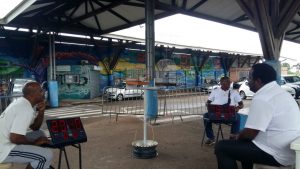
Let Song-bird Battle Commence!
Chap A turns up with his caged song-bird and hangs it up in the centre of the competition venue (mostly market squares). Chap B hangs his caged song-bird alongside. Chaps A and B then retire to a distance away from their birds. At a small desk close to each competing bird, sits an independent tweeting-judge (that’s the original tweeting, not the social media version 🙂 ). The tweeting-judges each have a button with a digital counting-display in front of them. Their task is to listen intently to their designated song-bird and press the button on the digital counter each time the bird tweets. A round begins when the adjudicator starts the clock, and ends after 6 minutes when he blows a whistle. The winner of each round is the bird which tweeted the most times during the 6-minute round. As I said… fascinating to watch… but only for a while!
Free-to-fly (or roam)
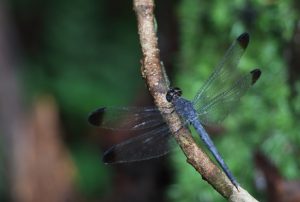 Anyway… notwithstanding the entertainment of competing song-birds, the ‘free-to-fly’ (or roam) wildlife is one of Suriname’s greatest attractions. The laboriously slow sloth crossing the road, the glistening colourful frog in the leaves, the extraordinary scarlet ibis amongst the Bigi Pan mangroves, snakes, spiders, lizards, dragon-flies… it’s so easy to find amazing nature here. We’ve added into the Suriname Photo Gallery below, a few of our favourite wildlife pics taken across the country.
Anyway… notwithstanding the entertainment of competing song-birds, the ‘free-to-fly’ (or roam) wildlife is one of Suriname’s greatest attractions. The laboriously slow sloth crossing the road, the glistening colourful frog in the leaves, the extraordinary scarlet ibis amongst the Bigi Pan mangroves, snakes, spiders, lizards, dragon-flies… it’s so easy to find amazing nature here. We’ve added into the Suriname Photo Gallery below, a few of our favourite wildlife pics taken across the country.
Next, we’re off to South American country No.9. Watch this space for Cuthbert’s report from Guyana!
Link to next blog: Guyana: Tolls and TV Stardom Link to full South America Blog
Suriname Photo Gallery
- Colonial
- Let Song-bird Battle Commence!

